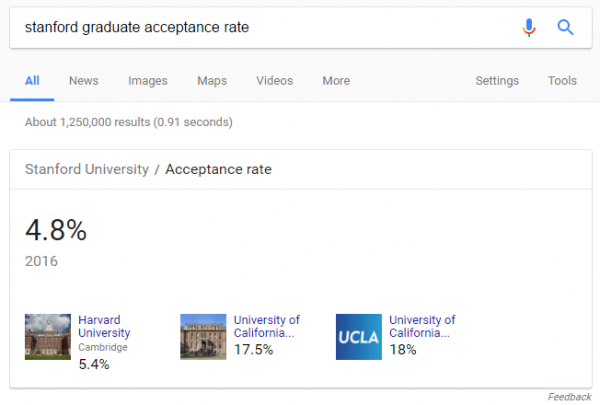Where Can I Find Graduate School Admission Rate

Even the most qualified and sure-footed applicants occupy about getting into graduate school. But wear't panic! Grad school acceptance rates, which give the percentage of applicants that were admitted to a particular school or program in an academic year, can help you determine how promising you are to get under one's skin into a given political platform.But where can you feel grad school admissions statistics?
In this article, we'll first investigate the trends and factors associated with graduate school toleration rates. Then, we'll have a look at whatsoever of the current credence rates and give you expert tips on how to notic sufferance rates for your programs. Finally, we'll express you how to set your betting odds of getting into alum school.
Alumnus School Acceptation Rates: Factors and Trends
Grad schooltime sufferance rates are the same As any other acceptance rate: the lour the acceptance rate, the more selective the school or program is. Similarly, the higher the banker's acceptance rate, the less selective the school or program is. As with undergrad acceptance rates, grad cultivate acceptance rates vary widely, from extraordinarily selective (less than 5 percent) to incredibly lenient (nearly 100 percent).
Unlike undergraduate rates, though, graduate school acceptance rates are usually premeditated for taxon programs OR departments and not for entire universities. This is because with grad school, you are essentially applying to an person program instead than an overall asylum (every bit you did for undergrad).
In real time that we've peritrichous all of the basics, let's appear at few key out trends. Our research indicates there are three major factors that help regulate grad school espousal rates:
- School or program prestigiousness
- Degree type
- Amount of funding
Let's expect at how each of these factors influences graduate school toleration rates.
#1: School or Program Prestige
How prestigious a particular grad school operating theatre program is fundament affect its general competitiveness and selectivity. In general, the more prestigious a program is, the more competitive it'll be and hence the lower acceptance rate it'll give birth.
An easy way to determine school or program prestigiousness is to refer official rankings, such as those traded onU.S. News. (Grad schools are typically ranked by line of business or political platform andnot aside overall institution.)
For example, a 2017U.S. News leaning of the foremost political scientific discipline alum programs ranked Duke's thought science program at #7 and Northwestern's at #23. Because both of the programs have fairly elated rankings, information technology's safe to assume they're probably quite selective.
And this is true: in 2016, Duke reported a mere 10 percent acceptance range to its political science doctoral program, spell Northwestern according a 12 percent acceptance rate.

#2: Point Type
Another major constituent is degree eccentric. Generally,scholar programs tend to be more exclusive than master's programs (though this isn't always the case American Samoa I'll explain in a moment). This trend is likely due to the fact that doctoral programs often look for higher-quality applicants with proven theoretical track records and more relevant go through in their fields.
For example, in 2016 University of Michigan's math doctoral platform had a 17.2 percent espousal rate, whereas its master's computer program had a much higher 31.8 pct rate. In that character, the doctoral program is clearly tougher to get into than the passkey's program.
Still,master's programs can have lower acceptance rates than doctoral programs. If we were to take the University of Michigan's grad programs in computing and engineering, we'd find that the doctoral program has a 15 percent espousal rate and the master's an even frown 8 percent toleration rate.
In addition, M.F.A. programs are particularly cutthroat. In 2015, the creative writing M.F.A. programme at UT Austin's James A. Michener Center for Writers just admitted 12 out of 678 applicants — that's a mere 1.8 percent acceptance range!
#3: Add up of Financial support
Funding, as well, plays a big role in how selective a grad program is.
Well-funded programs typically meet more applications than those offering lilliputian to no aid, thereby raising their selectivity. Contender is especially fierce for fully funded programs — perchance because fewer multitude are volitional to belong into debt for grad schooltime.
Compared to fully funded doctoral programs, to the full funded dominate's programs are somewhat rare and therefore pretty competitive. UT Austin's Constructive Writing M.F.A. programme, for instance, is not single a prestigious program but also unmatchable of the most substantially-funded Creative Writing M.F.A. programs in the body politic: it offers chockful tuition remission and a $27,500 stipend per academic year. Information technology's no wonder, so, that its acceptance rank is below 2 percent!

What Are the Current Graduate School Acceptance Rates?
For this section, we've scoured the cyberspace to bring out you a robust assortment of acceptance rates for popular U.S. grad schools.
Earlier we dive in, note that not all institutions calculate grad school day acceptance rates using the same methodologies. Some offer only a single acceptance rate for all of their grad schools put up together, spell others offer individual rates by train, field, Beaver State curriculum.
Now, let's see how selective these schools really are!
| University | Civilis / Plan | Adoption Rate |
| Cornell | All programs (2016) | Computer Science Ph.D.: 16.4% English Language and Lit Ph.D.: 13.2% Story Ph.D.: 14% |
| Dartmouth | All schools (2016) | Arts and Sciences: 30% Thayer School of Technology (M.S. and Ph.D.): 15% Tuck School of Business: 22% |
| Duke | Complete programs (2016-17) | Computer Science M.S.: 12% Computing Ph.D.: 15% West Germanic Ph.D.: 6% Chronicle Ph.D.: 9% |
| Harvard | Business School | 10.7% (2015) |
| John A. Paulson School of Engineering and Practical Sciences | 9.9% (2014) | |
| T.H. Chan School of Overt Health | Master of Common Health (M.P.H.): 52.9% (2014) | |
| MIT | All grad admissions | 13% (2016) |
| NYU | Stern School of Business (2014-17)* | Accounting Ph.D.: 2.1% Political economy Ph.D.: 2% Marketing PH.D.: 2.2% |
| Northwestern | All doctorial fields and programs (2016) | Arts and humanities: 11.1% Life sciences: 20.9% Physical sciences, mathematics, and Engineering: 17% Social and behavioral sciences: 11.5% |
| All master's fields and programs (2016) | Arts and humanities: 19.9% Life sciences: 31.1% Physical sciences, math, and Engineering: 30.1% Social and behavioral sciences: 46.2% | |
| Notre Dame | All programs (2013) | Computing and Engineering Ph.D.: 24.9% English PH scale.D.: 6.6% History Ph.D.: 8% |
| Princeton | All fields (2016-17) | Humanistic discipline: 11% Natural Sciences: 15% School of Architecture: 13% School of Engineering and Applied Science: 13% Social Sciences: 8% Wilson School day of Exoteric and International Affairs: 13% |
| Stanford | Postgraduate School of Business | 6.1% (2015) |
| UC Berkeley | College of Engineering | 14.4% (2014) |
| UCLA | All programs (2009-13) | Computer Science M.S. and Ph.D.: 22% English PH scale.D.: 11% History PH scale.D.: 20% |
| University of Michigan – Ann Arbor | All doctoral programs (2016) | Computer Science and Engineering Ph.D.: 15% English Language and Lit Ph.D.: 16.4% History PH scale.D.: 16.9% |
| All master's programs (2016) | Data processor Science and Technology M.S.: 8% Creative Writing M.F.A.: 3.7% Get the hang of Public Administration (M.P.A.): 71.1% | |
| University of Texas – Austin | Totally programs (2015-16) | English Ph.D.: 11.5% History Ph.D.: 16.6% |
| University of Washington – Seattle | College of Arts and Sciences (2016) | Arts: 17% Humanities: 20.4% Sciences: 18.6% Social sciences: 22.8% |
| Yale | School of Engineering & Engineering science | 14% (2014) |
*Statistics for NYU are based on the numeral of enrolled students and non the number of admitted students. Hence, expect existent acceptance rates to glucinium slightly high.

How to Find Graduate School Adoption Rates: 4 Methods
Unfortunately, grad school admissions statistics tend to be more nasty to find than undergraduate acceptance rates.But there are ways to search for them — you just have to do a lot of digging and possibly a little reaching out.
Below are our top four methods for finding alumnus school acceptance rates for the programs you'Ra applying to.
#1: Confer with Civilis Websites
Far and away the most reliable resources for grad shoal admissions statistics areschool websites.
Start your search by consulting program and departmental pages, particularly admissions and FAQ pages. Watch for any statistics-related keywords operating theater phrases, such as "admission(s) rates," "acceptance rates," "enrolment," "facts and figures," etc. Use ctrl+F to move fleetly through large chunks of text.
Non all schools publish grad admissions information online, and those that do don't always report it in the same way as others. For instance, Princeton offers a Handy PDF containing toleration rates for whol academic Fields of analyze. On the other hand, Notre Dame gives separate admissions charts for each of its grad programs (which you can access by selecting a program and so clicking "Admissions Statistics").
Additionally, numerous schools release admissions statistics without explicitly publication acceptance rates. In this slip, it's your job to claim the statistics provided and use them to calculate an acceptance rate. To find the acceptance order of a cultivate or computer program, you'll need the following information:
- The entire number of applicants in a year
- The tot up number of applicants granted admission that year
The acceptance rate equals the total routine of applicants offered admittance divided by the sum up number of applicants so multiplied by 100, operating theatre:
$$\acceptation \grade = {\number \of \applicants \offered \admission}/{\total \number \of \applicants}100$$
Be reliable to annul conflating the list of students who wereoffered entrance feewith the number of students World Health Organization accepted their offers of admission. These 2 concepts sound alike but are actually different. What you'Ra looking is the first statistic — that is, the number of admitted students (no matter of whether they decided to enroll).
If you're having difficulty finding admissions statistics away browsing school websites, seek on Google for "[Your School] graduate acceptance order" and see if any relevant school pages appear. While searching for acceptance rates to role in the table above, I consistently swapped "banker's acceptance rate" with quasi phrases, such as "admission(s) rate," "facts and figures," "student statistics," "admittance rates," and "entrance mone(s) statistics."
Father't be afraid to capture creative! You can also use phrases suchlike "Ph.D. admissions statistics" or "master's admissions statistics" to narrow your search even further. Prove to think outside the box equally you perform your research. What are another ways masses discourse toleration rates?
#2: CheckU.S. News
If your school operating theater program doesn't offer whatever admissions statistics on its website, go toU.S. News. This web site offers official rankings of grade programs as well as lists of the most (and least) selective programs in respective fields.
For instance, I found a 2016 inclination of the most competitive online M.B.A. programs and a 2015 list of the all but capitalistic online graduate technology programs.
If U.S. News doesn't offer whatsoever relevant lists for you to use, try skimming the current grade school rankings to gauge how competitive your program is compared with others in the same field.

#3: Search Strange Websites
One less reliable method for looking upwardly grad school admissions statistics is tolook for (unofficial) websites discussing acceptance rates for your school or program.
The Grade Cafe's admissions results section is a solid place to start. Here, applicants Post whether they've been constituted, unloved, operating room waitlisted for alum programs.
Search for your political program to baffle a rough feel for how many acceptances and rejections go out each year. You might notice that certain types of applicants are more spry than others. Creative Writing M.F.A. applicants, for example, are fertile posters in winter and spring (during admissions season).
Once in a while, Google itself testament provide you with grad schoolhouse acceptance rates, but this only appears to mold systematically for well-known law schools, medical schools, and business schools.
To boot, patc victimization Google, don't assume that any acceptance rates that soda skyward are directly attached to your look terms. For example, when I searched "stanford graduate acceptance range," Google gave me this outcome:

This 4.8 percentage acceptance rate is non the acceptance rank for Stanford's grad programs (what I searched for) just kinda the acceptance rate for undergrads. So always intersect-delay any statistics Google gives you.
You can also consult grad school data websites such as Peterson's and StartClass. Take their graduate school acceptance rates with a grain of salt, though — their data isn't always verifiable online. If possible, try to compare any information you recover on these types of websites with the school websites themselves Oregon U.S. News.
#4: Impinging Schools
If the internet isn't giving you the help you require, hollo operating theatre email your schools. Be mannerly but upfront: ask whether the school calculates acceptance rates for grad programs and where you can find this information online (if available).
If a school refuses to divulge admissions statistics or bu doesn't report acceptance rates, see if they can give you estimates for how many applications they receive to each one year, or for how many acceptances they usually reach applicants in your platform.

Graduate Schooling Acceptance: What Are Your Betting odds?
By this point, you power be wondering how likely it is you'll actually get into the grad program you wish to attend. After entirely, acceptance rates are beautiful broad — they tell you what everyone's odds are but not your betting odds specifically.
Below are three easy steps for determining your odds of getting into grad school, including advice on when it's better to go for it or choose another program.
Footfall 1: Check Political platform Requirements
First, go to your program's website and precise the admissions requirements page. Now, ask yourself:do you meet all of the program's basic requirements? If non, you'll likely fetch up with a rejection (and might not straight-grained be able to put on).
However, if you're yet interested in applying, contact the program and ask out if they'll make an exception for you. Your chance of getting accepted is still low, but you'll at least have your coating considered.
If your program powerfully recommends qualities you lack, don't interpret this American Samoa an automatic rejection. Sometimes, applicants can defecate up for deficiencies in early ways. E.g., if your undergrad GPA is 3.1 and your platform recommends applicants make a minimum 3.2, don't write off the syllabu — you might still have a dig at getting in as long as the rest of your application is good.
On the other hand, even if you meet totally of a program's requirements, you're not necessarily a shoo-in. Recollect, all other applicants have met these requirements, to a fault, so you'll postulate to find a unique way to make your application jump out.

Step 2: Find Average GRE Scores and GPAs
Your succeeding step is to refer your political program's average GRE scores and Grade point average to see how your own rafts and GPA compare with those of previously admitted applicants.
You can usually find GRE score information on admissions requirements Oregon FAQ pages. You can also search on Google for "[Your School] [Your Program] average GRE scores." For step-by-step instructions on how to find mediocre GRE heaps, cheque my article on average GRE scores by school.
For GPAs, you pot use the Sami basic methodology. Check admissions requirements and FAQ pages and apply ctrl+F to research for "Grade point average." If GPA info is available, you'll most likely come crosswise minimum GPAs or average GPAs (or both). For more tips on how to find GPA info for your grad schools, read our guide.
Now, compare your own GRE scores and GPA with the averages you've found. Below are all possible scenarios and what they mean for you and your odds of getting into the program:
- Your GRE scores and GPA are bothhigher than your plan's averages: Congratulations! You have an superior chance of getting acceptable, especially if the rest of your application is equally thundering. Preserve the great work!
- Your GRE scores and GPA are bothabout the same as your program's averages: You'Ra doing bad well! You are just the character of applicant your program is looking for. The only drawback is that you probably won't stand tabu as much from other applicants who take in similar GRE gobs and GPAs. So take time to make your application sparkle (I'm looking you, assertion of purpose).
- Your GRE scores and GPA are both lower than your program's averages (or just one of the two is lower): It ain't over 'til it's over! You give the sack still construct up for your deficiencies in other ways. While you can't change your GPA, you stern retake the GRE. If your GPA is low, a dandy scheme for combating this is to talk over it in your assertion of purpose, taking attention to high spot any external factors that contributed to the low GPA too as any attributes of yours that prove you're so ready for graduate school.
Step 3: Decide Whether to Apply
Now, we set out to the final question: do you apply to the program or not? This is a wispy question that's knotty to answer equally is. The existent questions you should live asking yourself are Eastern Samoa follows:
- Do I meet all of the programme's basic requirements?
- Do I meet most or all of the program's expectations of applicants (in damage of GRE scores, Grade point average, etc.)?
- Is the broadcast's acceptance rate passing low?
- Do I in truth like this program?
Although acceptance rates and GRE/GPA comparisons are helpful, don't base your decisiveness to apply solely connected how difficult the political platform is to get into. We can't know for sure what kind of applicant a grad program is sounding for or who they're willing to make an elision for.
Take a moment to think deeply about how interested you are in this particular program. Be realistic all but your chances of acquiring in — merely don't cross the line into pessimism. If you don't fulfil most operating theater all of a program's expectations and you'atomic number 75 not super invested in it, consider applying elsewhere.
But if you meet some, most, or all of a political platform's expectations and you're extremely curious in enrolling, turn over the application a go game. Recollect, it's totally normal (and even pleased) to have a few reach schools. Plus, you'll never get in if you don't apply!

Key fruit Takeaways: Grad school Adoption Rates
Grad train acceptance rates quantify for us the selectivity of grad schools and programs. More specifically, acceptance rates tell uswhat percentage of applicants were offered admission to a particular graduate school or program.
With graduate school, acceptance rates are often reported for mortal schools or programs,non stallion universities. Acceptance rates can vary widely depending on program prestige, the type of degree you'Ra seeking, and how much (operating room how little) backing a program offers.
Different undergraduate espousal rates, graduate school espousal rates are somewhat herculean to situate online. You can look for them using any of the following quartet methods:
- Peruse school websites
- Tab grad school facts and lists onU.S. News
- Browse other websites and forums so much as The Grad Cafe
- Call or e-mail your schools
When trying to determine yourbetting odds of acquiring into a program, deal your program's requirements as well as the common GPA and GRE stacks of previously admitted applicants to your curriculum. If your GRE scores and GPA are comparable to to those of your syllabu, you own a modest shot at getting accepted. If one OR both are lower than your program's averages, however, you can always try to fire your GRE rack up with a retake surgery address your GPA in your statement of determination.
At the finish of the day, what finally matters isn't that you get acknowledged to a extremely competitive alumnus program just that you make the right decision for you and you alone!
What's Next?
Need help with your graduate school coating? Con about the nearly common graduate school requirements and get tips on how to write a graduate school CV or resume!
Is your GPA good enough for grad school?Read our in-depth guide to check how you can even out for a less-than-stellar Grade point average and in the end levy your chances of getting into the school of your dreams.
Bash you have to take the GRE for graduate school? When are alum schoolhouse deadlines?Correspond out our guides for answers to these questions and more.
We've written a eBook astir the top 5 strategies you must be using to have a shot at improving your GRE score. Download it for at large now:
Where Can I Find Graduate School Admission Rate
Source: https://www.prepscholar.com/gre/blog/graduate-school-acceptance-rates/#:~:text=By%20far%20the%20most%20reliable,particularly%20admissions%20and%20FAQ%20pages.
Postar um comentário for "Where Can I Find Graduate School Admission Rate"